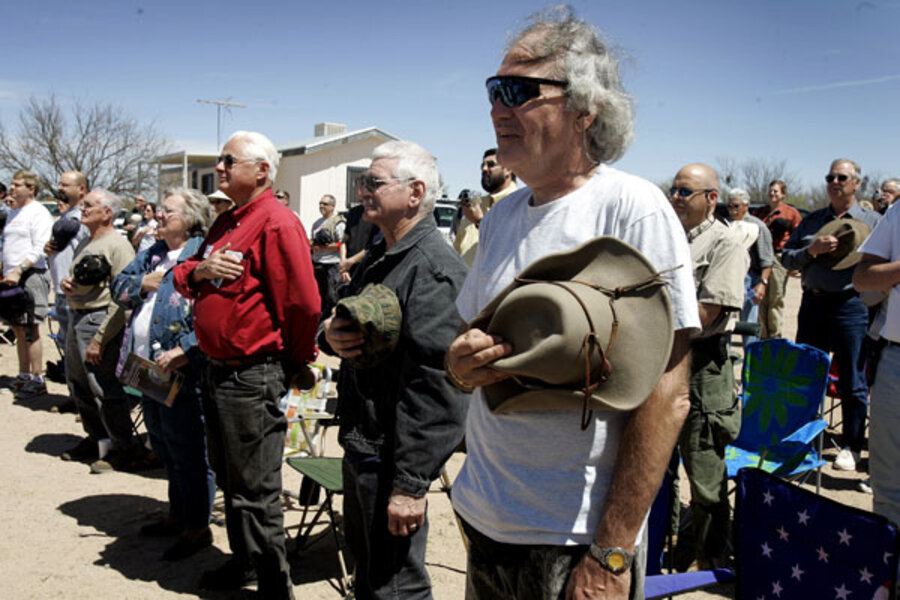What happened to Minuteman Project? It's still roiling immigration reform.
Loading...
| Tucson, Ariz.
In just a few years, perhaps the most visible civilian attempt to stop illegal immigration has all but disappeared amid the changing dynamics of the debate.
A little less than a decade ago, the Minuteman Project and the copycats it spawned arrived at the Arizona border with binoculars and American flags, vowing to defend the country from what they described as an invasion. At their height, the Minutemen were the face of a conservative insurgency that would later lend its energy to the emergence of the tea party.
To like-minded Americans, they were patriots. To critics, they were dangerous vigilantes.
Today, however, they have largely vanished. The recession took its toll, it seems, making an expensive enterprise impractical for workaday crusaders. So did infighting within the groups, as well as shifts in immigration patterns.
But the Minutemen were also victims of their own success, helping to forge a strident new movement against illegal immigration that continues to shape the political debate today. In a very real way, the Minuteman Project has lost momentum because politicians in state capitols and Congress have taken the lead. While several states from Arizona to Alabama have passed strong anti-illegal immigration laws, Republicans in the US House of Representatives have blocked comprehensive immigration reform legislation.
"The energy passed from the so-called citizen border patrol groups to state legislatures," says Mark Potok, an expert on militias and antigovernment groups at the Southern Law Poverty Center, in Birmingham, Ala.
In 2010, the center documented 319 groups active in Arizona and other parts of the Southwest border that, often armed, confronted people suspected of being in the country illegally. By 2013, the number had dwindled to 33.
"The movement is one-tenth the size that it used to be," says Mr. Potok.
In rural southeast Arizona, once a hotbed for militia-type patrols that began in the early 2000s, the absence is noticeable.
"We haven't had any contact with anyone identifying themselves as a militia and acting in that capacity for maybe the past two years," says Carol Capas, a spokeswoman for the Cochise County Sheriff's Department.
On occasion, those in search of illegal activity make their presence known. In August, authorities in central Arizona arrested a man they accused of pointing a gun at a Maricopa County sheriff's deputy in a desert miles from the border that is well known for the smuggling of people and drugs.
But by one important measure, the groups have already triumphed. They brought more attention to the border and illegal immigration, says Louis DeSipio, a political scientist at the University of California at Irvine.
"They offered a visual image to what was, for some, a sort of abstract debate," he adds.
Various factors contributed to the decline of the movement. The Minuteman Project itself, which secured the national spotlight in 2005, eventually succumbed to infighting and controversy. Criminal elements with ties to the organization caused damage, as did associations with people espousing white supremacy. Chris Simcox, a former leader of the movement, awaits trial in Phoenix on sexual-assault charges, while another leader, Shawna Forde, remains behind bars after being convicted and sentenced to death on murder charges linked to the killing of a 9-year-old girl and her father during a home invasion in southern Arizona.
On a basic level, maintaining a movement whose members came from various parts of the country was always going to be difficult, says Lisa Garcia Bedolla, a political scientist at the University of California at Berkeley.
A sharp drop in illegal border crossings, as well as the economic downturn, probably accelerated the collapse of the groups, she says.
"It's probable that the people who are doing the watching have fewer resources; it takes money to take the time to sit there. And then you also have the changes in the migration patterns."
Although border security and anti-immigration sentiments prevailed even before the Minutemen came along, the image of members dressed in military-style clothes represented "a very visual reaction to a sense of insecurity and fear," she says.
"The rhetoric was already there, they were just taking it to an extreme," Professor Garcia Bedolla adds. "Maintaining that extreme takes a lot of resources, it takes a lot of energy."
At their height, Minuteman-style groups enjoyed a clout that reached far beyond their membership numbers.
"It certainly wasn't them alone. If it had been them alone, the border vigilantes wouldn't have succeeded," Professor DeSipio says.
Despite their relatively low numbers, the groups were able to rally other like-minded individuals, including prominent talk show hosts with large audiences.
"In that, they were overwhelmingly successful, if we think about how strident the anti-immigrant organizing is now," he adds.
DeSipio notes that the rise of the Minuteman movement coincided with the last time Congress attempted (and failed) to pass comprehensive immigration reform.
In 2006, the House and Senate each approved legislation that addressed border security and the potential legalization of the estimated 12 million people in the country illegally. But the House and Senate proved unable to bridge the differences between the two proposals, and the attempts for reform crumbled.
"People who would've have, maybe, voted for a compromise on immigration suddenly realized that their votes were at risk, so they moved away from immigration reform," he says.
Since then, numerous border watchers have gravitated toward the rising tea party and begun spreading their anti-immigration-reform message through political channels. Today, that political pressure is influencing Republicans in the House, who have refused to take up an immigration reform bill passed by the Senate last year.
Says DeSipio: "I think that's why we haven't seen a comprehensive bill since 2006."







